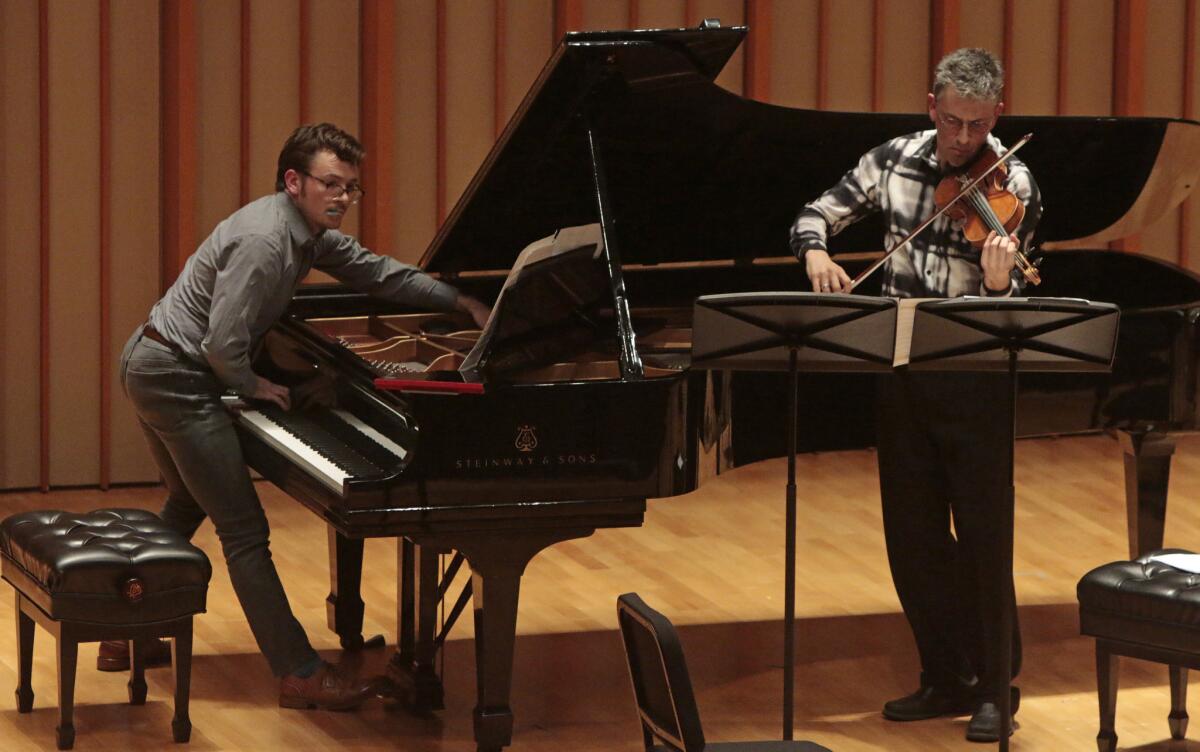Review: An evening of sophisticated new Spanish music

- Share via
From the time of its empire to well into the 20th century, Spain was a country so immediately recognizable by its music that eventually guitars and boleros became clichés. But now, like much new music in much of the world, the Spanish style has assumed an international, cosmopolitan character.
Perhaps this explains why we hear so few works from Spain outside Spain these days.
But there is excellent, sophisticated new Spanish music, Spanish in ways that go beyond the clichés, and Monday Evening Concerts began its 2014-15 season (finally), and the new year, at the Colburn School’s Zipper Concert Hall with a program of Spanish works, most new to our country, from the last four decades.
The big event was the U.S. premiere of Ramon Lazkano’s “Igeltsoen Laborategia” (Laboratory of Chalks). A 46-year-old Basque composer, Lazkano found inspiration for a series of short cycles of chamber pieces written between 2005 and 2009 from small chalk sculptures by the late Basque artist, political activist and theorist Jorge Oteiza.
This is striking, musically, conceptually and, once you listen for it, nationally. Unconventional scores may not be expected to sound conventionally Spanish. Moreover, the Basque region, with its growing separatist movement, has not only its own language and identity but also inescapable ties to neighboring France. And like many great Spanish composers before him — Manuel de Falla and Federico Mompou among them — Lazkano picked up his essential technique in Paris.
What most characterizes Lazkano’s pieces are their otherworldly fragility, for which the French spectral school offers useful techniques. Many are studies in breakable connection, in the impermanence of links. The whiteness and brightness of chalk, the composer has written, make it a medium ideal for drawing signs and leaving messages, but chalk crumbles, its signs and messages erode and turn to dust.
This then becomes a metaphor for Lazkano’s interest in producing ghostly overtones, spectral sounds in which there is not always a there there. These sounds are Lazkano’s mystical way into Oteiza, who once wrote that art “always departs from a nothing that is nothing and concludes in another Nothing that is Everything.”
Chalk also has this in common with ghosts, namely the ability to produce goose bumps. It squeaks when drawn against a board. Nothing is quite so real a sound as that. Lazkano takes literal note.
The “Chalk” cycles played Monday included four “Wintersonnenwende” (Winter Solstice), two “Errobi” (Dual Roots) and the single “Egan” (Flying Away). Their orders were mixed. The instruments ranged from cello and piano to a sextet that also included violin, viola, flute, clarinet and percussion. For nearly 80 minutes, various combinations of sounds, whether fresh and present or immaterial, beautiful and grating, appeared and vanished, leaving traces of sonic dust — and the occasional goose bumps.
Lazkano, for instance, has a particular flair for the cello, played Monday with alluring verve by Séverine Ballon, who produced Space Age glissandi or precise, fleeting dramatic gestures, poofs of sound.
The other musicians — violinist Mark Menzies, violist Andrew McIntosh, flutist Alice Teyssier, clarinetist Brian Walsh, percussionist Nick Terry and keyboard player Richard Valitutto — had equally daunting challenges. All were asked to find inventive ways of producing new sounds, which might also seem Spanish in the way that, say, Catalan chef Ferran Adrià experimented with molecular gastronomy. All were outstanding.
The program began with Francisco Guerrero’s “Delta Cephei,” for string trio and two clarinets from 1992, another U.S. premiere. An avant-gardist who died in 1997 at 46, Guerrero relied on microtonal tunings to create strong sounds, acoustic instruments stretched to their not always pleasant edge.
Luis de Pablo, the dean of Spanish music who turns 85 later this month, was represented by “Le Prie-Dieu sur la terrasse” for percussionist. This is from the stylistically varied composer’s experimental period in the early ‘70s. Jonathan Hepfer, who also served as capable conductor in the other works, found a wealth of interesting effects from dragging a bell across a bass drum.
The idea for the 20-minute piece came from a vision the composer had while visiting a snowy Canadian landscape. The technique came from the prevailing German avant-garde approach at the time. The piece was written for an American percussionist. But the spellbinding sense of ritual that Hepfer’s performance conveyed felt ultimately, if ineffably, Spanish.
Twitter: @markswed
More to Read
The biggest entertainment stories
Get our big stories about Hollywood, film, television, music, arts, culture and more right in your inbox as soon as they publish.
You may occasionally receive promotional content from the Los Angeles Times.











